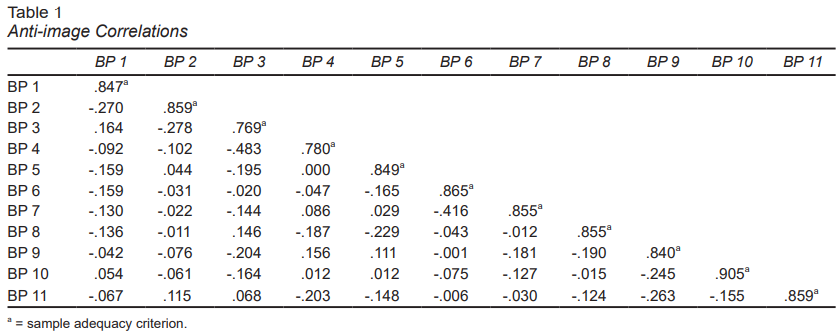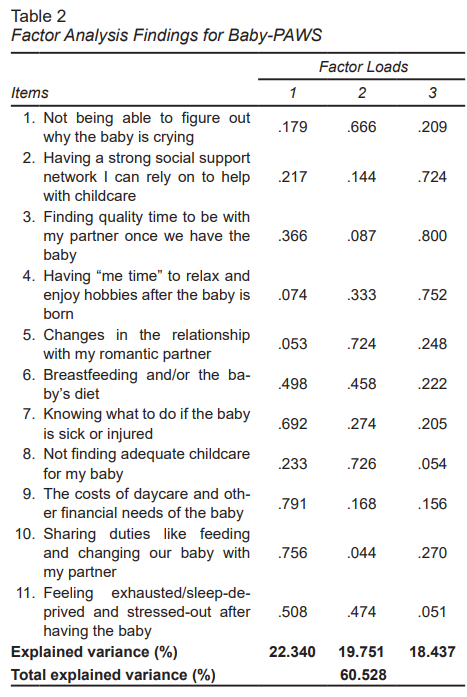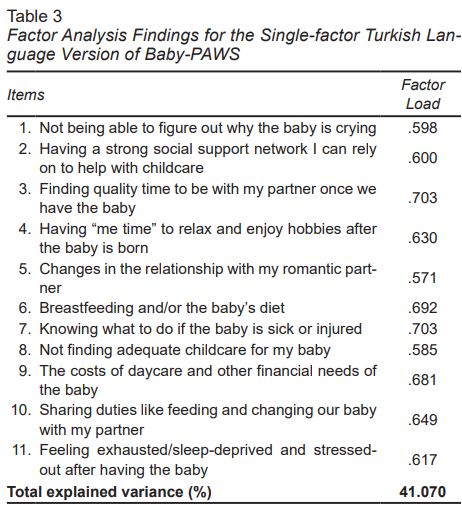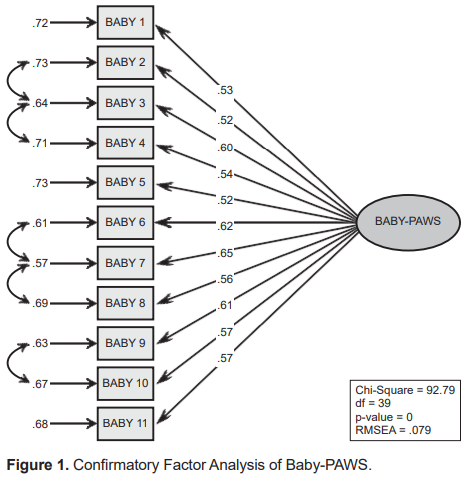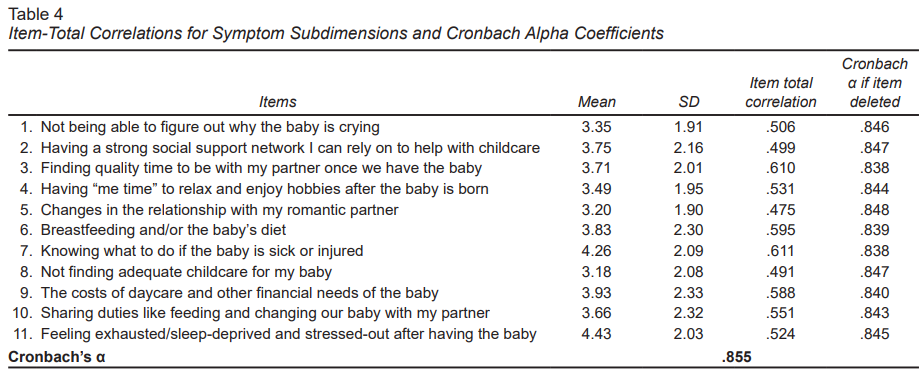INTRODUCTION
The transition from pregnancy to parenthood is one of the most radical changes that occurs in women’s lives (Versele et al., 2022). As a result of significant physiological and psychological changes experienced during this transition, expectant mothers can experience worry, general anxiety or anxiety disorders according to the criteria in the Diagnostic and Statistical Manual of Mental Disorders-5 (DSM-5) (Rees et al., 2019; Arifin et al., 2021). Worry is a cognitive event accompanied by concerns related to future events, which usually cannot be controlled and are perceived to have negative or uncertain outcomes. Worry related to birth may be affected by factors such as previous pregnancy and birth experiences, labor, problems during pregnancy, social support or other people’s negative stories about birth (Abdi et al., 2018). Anxiety disorders differ from normal feelings of worry and stress; generalized anxiety disorder involves continuous feelings of worry together with physical symptoms such as restlessness, tiredness, muscle tension and insomnia, affecting daily life (World Health Organization [WHO], 2020). Antenatal anxiety symptoms reported by expectant mothers may be associated with fears related to pregnancy (such as congenital disorders or miscarriage) or a pre-existing situation and may continue with or without depressive symptoms (Centre of Perinatal Excellence [COPE], 2017).
During pregnancy, a woman has an increased propensity to worry. Even in low-risk pregnancies, 26% of women experience anxiety, while anxiety rates are reported to be up to five times higher in high-risk pregnancies (those with obstetric complications, weak social support and a history of anxiety or depression in the woman or family) compared to low-risk pregnancies (Rees et al., 2019; Wu et al., 2020; Doty et al., 2022).
During the prenatal period, many women are observed to experience worry, anxiety and depression symptoms at levels that can negatively affect maternal health, parenting, and mother-infant interaction (De Asis-Cruz et al., 2020). Children of mothers experiencing high anxiety during the prenatal period have been reported to have a high probability of preterm birth, be small for their gestational age and have behavioral and emotional problems that may continue after childhood (Grigoriadis et al., 2018; Frigerio & Nazzari, 2021). Findings in the literature results show that antenatal maternal stress increases negative health outcomes across children’s lifespan (Uguz et al., 2019; Weis et al., 2020; Wu et al., 2020).
National studies performed to determine anxiety status in pregnancy appear to use newly developed scales or scales that have been validated for the Turkish population. These scales include the Pregnancy-related Anxiety Scale, Perinatal Anxiety Screening Scale and Perceived Stress Scale (Örücü & Demir, 2009; Yazıcı et al., 2019; Kurt & Arslan., 2021) These assessment tools are generally designed to diagnose a single problem, and there are none focusing on practical concerns (such as the ability to care for the baby, securing childcare, personal well-being, and spouse involvement) or measuring expectant mothers’ concerns about the transition to parenthood. There is a need for reliable, valid tools to detect significant components of prenatal distress, such as worry and anxiety, that place women and children at high risk when experienced during pregnancy and labor. Creating a Turkish language version of an objective scale tool to measure baby preparation and worry, and examining its validity-reliability, will make it possible to identify the concerns of soon-to-be mothers related to the transition to parenthood, baby care, well-being and partner participation with a valid, reliable scale.
The aim of this study was to adapt the Baby Preparation and Worry Scale (Baby-PAWS) developed by Erickson et al. to Turkish culture and perform validity and reliability studies to add a new scale tool specific to this field to the literature.
METHOD
Design of the study
This is a prospective, observational validity and reliability study.
Language Validity
The original English version of Baby-PAWS was adapted to Turkish using the translate-retranslate technique. It was translated into Turkish by two professional translators with a good level of English and subsequently checked by a lecturer proficient in English who chose the most suitable translation for each item. The Turkish version of the scale was subsequently retranslated from Turkish to English by a linguistic expert and the items compared with the original scale to ensure equivalence.
Content Validity
Once the linguistic validity of Baby-PAWS had been determined, it was examined by five experts to ensure that content validity including cultural equivalence had been provided. Content validity was assessed using the Davis technique. The CVI points for the items on the Baby Preparation and Worry Scale were between .90 and 1.0. Content validity was therefore ensured without having to remove any items from the scale.
Participants
The population for this study comprised expectant mothers in the third trimester contacted online through pregnancy platforms (Instagram, Facebook, pregnancy class WhatsApp groups, etc.). For sample calculations, the sample included 220 expectant mothers, fulfilling the criterion that the sample number should be at least twenty times the number of scale items (eleven items) (Potur et al. 2015; Altıparmak & Taş Arslan, 2016). The sample for the research included pregnant women in keeping with the inclusion criteria of the study.
Research inclusion criteria. Married women (women in Turkish society avoid disclosing pregnancy outside marriage due to social pressure), over the age of eighteen, who had at least completed primary school, were in the third trimester of pregnancy and agreed to participate in the study were included.
Research exclusion criteria. Pregnant women with chronic diseases or a history of psychiatric disorders were not included in the research.
Measurements
The Personal Information Form, Depression, Anxiety and Stress Scale-21 (DASS-21) and Baby Preparation and Worry Scale linguistically validated for the Turkish population were used for data collection.
Personal Information Form
This form included questions on the age, employment status, educational attainment, partner’s educational attainment, income level, family type, length of marriage and obstetric features of the expectant mother.
Depression Anxiety Stress-21 Scale
The Depression Anxiety Stress Scale-21 (DASS-21) was developed by Lovibond and Lovibond (1995) and adapted to Turkish by Sarıçam (2018). The scale, comprising twenty-one items, has 4-point Likert type responses: 0 ‘does not apply to me’, 1 ‘applies to me a little’, 2 ‘generally applies to me’ and 3 ‘fully applies to me.’ Each subscale related to depression, anxiety and stress contains seven items and participants were asked about the degree to which these statements had applied to them in the past week. Points on the scale were calculated adding the total for the 0, 1, 2, and 3 point selections. The cut-off points are > 4 for the depression subscale, > 3 for the anxiety subscale and > 7 for the stress subscale. The Cronbach alpha internal consistency reliability coefficients for the scale were .81 for the stress subscale, .85 for the anxiety subscale and .87 for the depression subscale.
Baby Preparation and Worry Scale
The Baby Preparation and Worry Scale (Baby-PAWS) was designed to measure concerns related to the practical aspects of the transition to parenthood. The full title of the article by Erickson et al. (2020) was “Baby Preparation and Worry Scale (Baby-PAWS): Instrument development and psychometric evaluation.” The revised 2020 version of the scale comprises eleven items. The original form of the scale had subdimensions on ‘self and partner worry,’ ‘non-parental childcare worry,’ and ‘baby care worry.’ Items on the scale were rated according to a 7-point Likert scale (1 = never,
2 = very rarely, 3 = less than half the time, 4 = about half the time, 5 = more than half the time, 6=almost always, 7=always). The Cronbach alpha coefficients for the scale subdimensions were α = .90, ω = .91 for self and partner worry; α = .77, ω = .79 for non-parental childcare worry; α = .74,
ω = .75 for baby care worry; and α = .89, ω = .90 for the eleven-item Baby-PAWS. This is the first tool specially designed to measure worry related to the practical aspects of the transition to parenthood and provides an important basis with a three-factor structure and internal consistency.
Statistical analysis
The linguistic validity of the scale was ensured using the translate-retranslate method. The content validity index (CVI) was determined based on expert opinion. The LISREL 8.80 and SPSS Statistics VS 22 programs were used for data analysis, including percentages, numbers, minimum and maximum values, and mean and standard deviations for descriptive statistics. The Davis technique was used for content validity; GFI, x2/SD, CFI, RMSEA, SRMR, AGFI fit indexes and PATH diagram were used for confirmatory factor analysis (CFA); basic component analysis, Bartlett and Kaiser-Meyer-Olkin (KMO) coefficients were used for exploratory factor analysis (EFA); and item-total correlations and Cronbach alpha coefficient techniques were used for internal consistency.
Ethical considerations
Permission was obtained from Erickson by email to perform Turkish validity and reliability studies for Baby-PAWS. Permission was obtained from the Ordu University Clinical Research Ethics Committee for the research (Decision Number: 2021/160). Expectant mothers agreeing to participate in the study provided written consent through Google Forms.
RESULTS
The mean age of the expectant mothers participating in the study was 30.26 ± 6.05 years, while the mean number of pregnancies was 1.78 ± .92. Of this group, 41.8% had completed undergraduate or higher education, 60% were housewives, 67.3% had incomes equal to expenditure, 82.7% had not previously miscarried, 77.7% had planned their pregnancies, 64.1% had not received prenatal care, 86.4% did not have risky pregnancies, 95.5% did not have genetic inherited disease and 50% were expecting a boy.
Investigation of Validity of Baby Preparation and Worry Scale
Findings related to Construct Validity
Once content validity had been determined, factor analysis was examined to identify the construct validity of the Baby Preparation and Worry Scale. Prior to this, Bartlett’s and KMO tests were performed to assess the adequacy of the sample size and the suitability of the data for factor analysis. The KMO value was .841. This value means that the data were suitable for basic component analysis. The Bartlett test result showed that the data were related to each other and suitable for factor analysis (x2 = 810.830, p = .000).
In addition, the anti-image correlations of Baby-PAWS items were assessed to determine whether the research data were suitable for factor analysis. All items met the sample adequacy criterion (Table 1).
Findings Related to Exploratory Factor Analysis
In the original Baby-PAWS, items 3, 4, 5, 10 and 11 were in the ‘self and partner worry’ dimension, items 2, 8 and 9 in the ‘non-parental childcare worry’ and items 1, 6 and 7 in the ‘baby care worry’ dimension. However, in the Turkish version of Baby-PAWS, several items were placed in different dimensions. In the Turkish version, items 2, 3 and 4 were placed in the ‘self and partner worry’ dimension, items 1, 5 and 8 in the ‘non-parental childcare worry dimension and items 6, 7, 8, 9 and 10 in the ‘baby care worry’ dimension. However, this distribution showed no similarity with any theoretical or conceptual structure. It was therefore decided to investigate the scale again as a single dimension (Table 2).
When Baby-PAWS was investigated as a single dimension, all the items had factor loads of .30 and above and explained variance was 41.070%. Therefore, no items were removed from the scale and the scale was accepted as having a single dimension structure. After EFA, to ensure further guarantees for findings, a structural equation model was created using CFA (Table 3).
Findings related to confirmatory factor analysis. Many indexes were used to determine the fit of the model for Baby-PAWS, finding values of x2/SD 2.38, AGFI .97, GFI .98, SRMR .063, RMSEA .079 and CFI .99. Based on these goodness of fit indexes, the model proved to be acceptable in its current t form.
Factor loads in the model varied from .52 to .65. There were five modifications to the model with items 2-3, 3-4, 6-7, 7-8 and 9-10 associated with each other. In the model, all t values were above 1.96 (7.12-11.22) (Figure 1).
Findings Related to Internal Consistency
The Cronbach alpha coefficient for Baby-PAWS was found to be .855. The item-total correlations for all items on the scale were above .40, and the removal of items did not cause a significant increase in the Cronbach alpha coefficient for the scale. As a result, no item was removed from the scale at this stage (Table 4).
Parallel Form Results
There was a statistically significant, low-level, positive correlation between Baby-PAWS points and Depression, Anxiety and Stress Scale points (p < .05). The Spearman Rho coefficient was between .135 and .251, ensuring the desired level of correlation between the two scales.
Expectant mothers were found to have total mean points of 40.79 ± 14.79 (interval 11-77) for Baby-PAWS. Participants received the highest score of 4.43 for the item ‘feeling exhausted/sleep-deprived and stressed-out after having the baby.’ The lowest score of 3.18 were obtained by participants for the item ‘not finding adequate childcare for my baby.
DISCUSSION AND CONCLUSION
International methods used to adapt a scale developed in a different culture include ensuring linguistic equivalence, performing validity and reliability studies, and comparing intercultural features (Çapık et al., 2018). The linguistic adaptation of the Baby-PAWS was performed using the translate-retranslate technique and it was found that the Turkish version is a suitable tool for measuring language equivalence.
Content validity is used to determine the adequacy of a scale tool in qualitatively and quantitively measuring a particular concept (Kartal & Bardakçı, 2018). The opinions of five lecturers who were experts in the field were used to measure the content validity of Baby-PAWS. The experts were asked to assess the cultural suitability, understandability and suitability for purpose. Using the Davis technique, the content validity of the scale was assessed and the experts were found to agree. According to the literature, the content validity index (CVI) in the Davis technique should be greater than .80 (Jesus & Valente, 2016). Based on the results, it was concluded that Baby-PAWS had adequate content validity.
In scale development studies, construct validity is examined to assess the ability of the scale to measure the related construct. In this case, the recommended analysis method is factor analysis (Jesus & Valente, 2016). CFA and EFA were undertaken for factor analysis. CFA was performed to determine whether the items could be grouped into various dimensions and whether the scale had subscales (Yaşlıoğlu, 2017). When the distribution into factors of the items in Baby-PAWS was investigated, the original structure separated into three subscales. However, the Turkish structure did not resemble this and the decision was made to review it as a single dimension. In the Dutch validation of the scale, the scale was found to be four dimensional (Bruinhof et al., 2024). This difference may be due to cultural differences and the fact that our data was collected on an online platform. The suitability of the data set was assessed using the Bartlett test and Kaiser-Meyer-Olkin (KMO) coefficient (Yöyen, 2016). Based on the KMO value (.841) and the Bartlett test (p = .000) for Baby-PAWS, the data were found to correlate with each other and be suitable for factor analysis. The strength of our study lies in the fact that it has sufficient power for factor analysis.
Baby-PAWS, investigated in a single dimension with eleven items, had factor loads varying from .571-.703. The factor loads for all the items on the scale were above .30 and explained variance was 41.070. As a result, no items were removed from the scale and the single-dimension structure was adopted. To obtain more definitive results after CFA, EFA was undertaken with structural equation modeling. Many indexes were examined to assess the fit of the model for the Baby Preparation and Worry Scale. According to the literature, SRMR and RMSEA values should be below .08, while the AGFI, CFI, and GFI values should be above .90 (Wang & Wang, 2012). Based on the relevant goodness of fit values, the model was concluded to be acceptable in this form.
Based on analyses of the structural equation example, after identifying an effective matrix, the output page of the analysis software was used to create a PATH index. In addition to the fit indexes, and the variables, factor loads, t values, the range of goodness of fit values and unexplained variances are summarized in this diagram. In short, outputs from the model are presented in graphic form (Çapık, 2014). In our study, the factor loads for the model varied between .52 and .65. In conclusion, the 11-item Baby-PAWS single-factor structure fit the model and the scale had construct validity.
The Cronbach alpha reliability coefficient method is generally used to determine the internal consistency of scale tools. The Cronbach alpha coefficient varies between 0 and 1. The closer the Cronbach alpha coefficient is to 1, the greater the reliability of the scale (Polit & Beck, 2009). The eleven items from the original version of Baby-PAWS had Cronbach alpha values of .89, with values of .90 for the first subscale (self and partner worry), .77 for the second subscale (non-parental childcare worry and .74 for the third subscale (baby care worry) (Erickson et al., 2020). Bruinhof et al. (2024) found the Cronbach alpha values of Baby-PAWS to be .85. In our study, the internal consistency Cronbach alpha reliability coefficient for Baby-PAWS was assessed and the scale was deemed to be highly reliable (α = .855).
Another method for measuring internal consistency is item-total points correlation, used to provide information on the reliability of each item on the scale. The variance of individual items is compared with the variance of the total test points and correlations are interpreted. For items to be acceptable, the item-total correlation coefficient should be at least .20. Items with values of less than .20 are removed from scales as they reduce reliability (Erdoğan et al., 2014). In Baby-PAWS, all items had item-total correlation above .30 and no notable increase occurred in the Cronbach alpha coefficient by deleting any item. As a result, no item was removed from the scale at this stage. This result confirmed the reliability of the items in the scale.
There was a statistically significant, low level, positive correlation between the points on Baby-PAWS and the Depression Anxiety Stress Scale-21 used in parallel (p < .05). As the Spearman Rho coefficient was between .135 and .251, the desired level of correlation was ensured between the two scales. This result shows that the greater the worry related to the baby preparation process among expectant mothers, the higher the depression, anxiety and stress levels.
In conclusion, the one-dimension Baby Preparation and Worry Scale was found to be a valid, reliable scale tool suitable for Turkish culture.
The Baby Preparation and Worry Scale is recommended for use as a tool to identify the practical concerns of expectant mothers, such as their ability to care for the baby, provide child care, maintain personal well-being, and involve their partners. It is also suggested for use in interventional research related to baby preparation and worry. The validity and reliability of the scale should be further evaluated by using it in research with different sample groups. Additionally, correlations should be examined by using the scale in conjunction with other scales.
Limitations
This study has certain limitations, which should be taken into consideration when interpreting results. 1) The sample was obtained in online environments and only married women participated. Other women with limited access to the online environment were excluded, limiting the generalizability of results. Future research should expand the study population. 2) Response bias may have occurred due to the difference in cultural backgrounds. Although the survey was anonymized, this may have influenced results. Future research with a more diverse sample would allow for an examination of Baby-PAWS across socioeconomic strata and women experiencing perinatal health issues.
